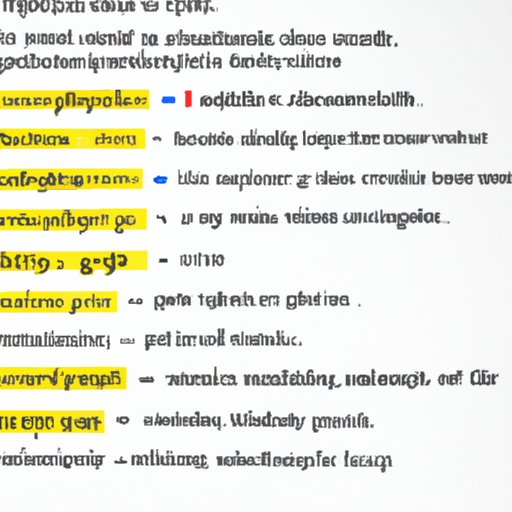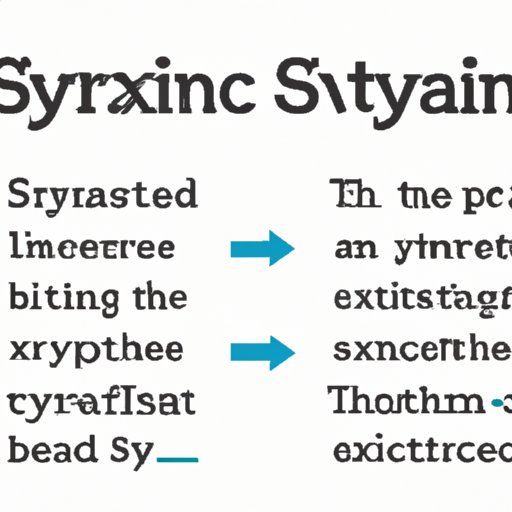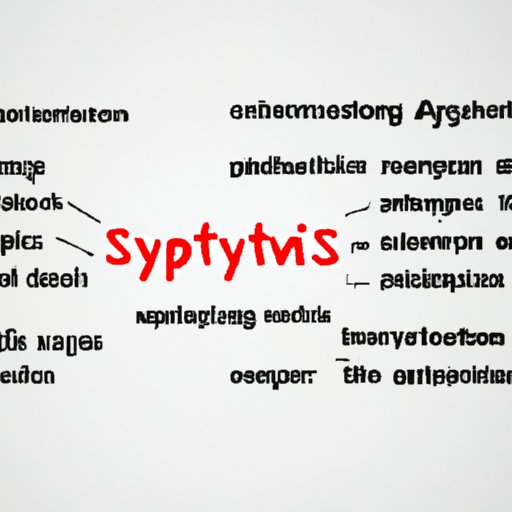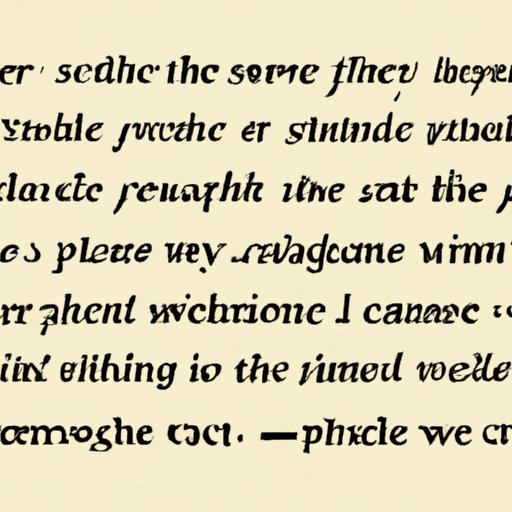Introduction
Syntax is a key element of written language. It refers to the way words are arranged to form phrases and sentences. In literature, syntax can be used as a tool to create certain effects and meanings. By understanding how to use syntax effectively, authors can communicate their message more clearly and powerfully.

Definition of Syntax in Literature
Syntax is the arrangement of words and phrases to create well-formed sentences in a language. It involves the use of grammar rules such as subject-verb agreement, verb tenses, and punctuation. In literature, syntax is used to convey ideas, emotions, and images. Authors may use specific syntax patterns to create emphasis, add variety to their writing, or convey a certain tone.
Overview of the Different Types of Syntax Used in Literature
There are four main types of syntax used in literature: simple sentences, compound sentences, complex sentences, and compound-complex sentences. Each type has its own unique structure and purpose.
Simple Sentences
A simple sentence consists of one independent clause with no subordinate clauses. It has a single subject and verb and expresses a complete thought. Simple sentences are often used to emphasize an important point or draw attention to a particular idea.
Compound Sentences
A compound sentence consists of two or more independent clauses that are joined by a coordinating conjunction (e.g., for, and, nor, but, or, yet, so). This type of sentence is often used to express contrast or show a cause-and-effect relationship.
Complex Sentences
A complex sentence contains one independent clause and one or more subordinate clauses. The subordinate clause provides additional information about the independent clause and is usually introduced by a subordinating conjunction (e.g., although, because, since, if, when, etc.). Complex sentences can be used to create suspense or add depth to a sentence.
Compound-Complex Sentences
A compound-complex sentence consists of two or more independent clauses and one or more subordinate clauses. This type of sentence is used to express multiple ideas at once or to add complexity to a sentence.

Understanding How Syntax Enhances Writing
By understanding the different types of syntax used in literature, authors can use them to create emphasis, add variety to their writing, and convey a certain tone.
Creating Emphasis
Syntax can be used to create emphasis in a sentence or paragraph. For example, a writer might use short, simple sentences to stress a particular point. Or they might use a series of compound sentences to highlight a contrast between two ideas. By using different syntax patterns, authors can draw attention to specific words or phrases and emphasize their importance.
Adding Variety to Writing
Using different types of syntax can also help add variety to a piece of writing. By combining simple, compound, complex, and compound-complex sentences, authors can create interesting and varied structures that keep readers engaged. This can make a text more engaging and easier to read.
Conveying Tone
Syntax can be used to convey a certain tone or mood in a text. For example, shorter and simpler sentences can create a sense of urgency while longer and more complex sentences can create a more reflective atmosphere. Authors can use these techniques to evoke certain emotions in their readers.
Examples of Literary Texts that Utilize Syntax
Many classic works of literature have used syntax to create specific effects. Here are some examples of how authors have used syntax to enhance their writing:
William Shakespeare’s “Sonnet 18”
In William Shakespeare’s famous sonnet, “Shall I compare thee to a summer’s day?”, he uses a variety of syntax patterns to create emphasis and convey his feelings. The poem begins with a simple sentence: “Shall I compare thee to a summer’s day?” This creates a sense of directness and urgency. He then uses a series of compound sentences to emphasize the beauty of the person he is addressing: “Thou art more lovely and more temperate./Rough winds do shake the darling buds of May…” This helps to create a vivid image and convey his admiration for the person.
T.S. Eliot’s “The Love Song of J. Alfred Prufrock”
T.S. Eliot’s poem, “The Love Song of J. Alfred Prufrock”, utilizes a range of syntax patterns to create tension and reflect the protagonist’s inner turmoil. The poem begins with a long, complex sentence: “Let us go then, you and I,/When the evening is spread out against the sky/Like a patient etherized upon a table.” This sentence conveys a sense of confusion and uncertainty, which reflects the protagonist’s state of mind. Eliot then uses a series of shorter, simpler sentences to emphasize his fear and anxiety: “Do I dare/Disturb the universe?/In a minute there is time/For decisions and revisions which a minute will reverse.”
Charlotte Bronte’s “Jane Eyre”
Charlotte Bronte’s novel, “Jane Eyre”, also makes effective use of syntax to convey the protagonist’s emotions. Throughout the novel, Bronte uses a combination of simple, compound, and complex sentences to emphasize Jane’s inner struggles and her growth throughout the story. For example, when Jane is feeling overwhelmed by her new situation, Bronte uses shorter, simpler sentences to convey this sense of helplessness: “My world had for some years been in Lowood: my experience had been of its rules and systems; now I remembered that the real world was wide, and that a varied field of hopes and fears, of sensations and excitements, awaited those who had courage to go forth into its expanse, to seek real knowledge of life amidst its perils.”

Analyzing Syntax and Its Effects on Meaning
When analyzing a piece of literature, it is important to look at the syntax and consider how it affects the meaning of the text. To do this, readers should identify key grammatical structures, examine the impact of word order, and evaluate the use of figures of speech.
Identifying Key Grammatical Structures
When analyzing syntax, it is important to identify key grammatical structures such as simple sentences, compound sentences, complex sentences, and compound-complex sentences. These structures can help to reveal the author’s intentions and shed light on the text’s overall meaning.
Examining the Impact of Word Order
Word order is another important factor to consider when analyzing syntax. For example, the placement of modifiers (adjectives, adverbs, etc.) can change the meaning of a sentence. Similarly, the placement of conjunctions and other connecting words can affect the flow of a sentence and the way it is interpreted.
Evaluating the Use of Figures of Speech
Figures of speech are also important to consider when analyzing syntax. They can be used to create vivid imagery, add emphasis, or convey emotion. Identifying and evaluating the use of figures of speech can help readers better understand the author’s message.
Conclusion
Syntax plays an important role in literature. By understanding the different types of syntax used in literature and how to use them to create emphasis, add variety to writing, and convey a certain tone, authors can communicate their message more effectively. Analyzing syntax can also help readers gain insight into the text’s overall meaning. As this article has shown, syntax is a powerful tool for writers and readers alike.
(Note: Is this article not meeting your expectations? Do you have knowledge or insights to share? Unlock new opportunities and expand your reach by joining our authors team. Click Registration to join us and share your expertise with our readers.)
